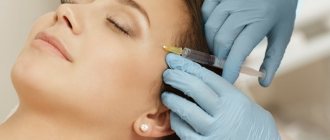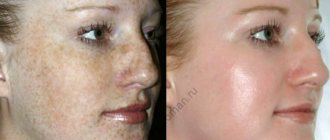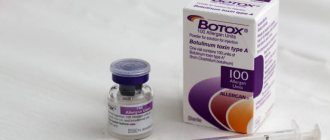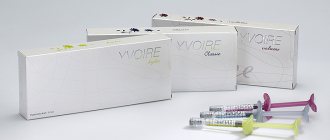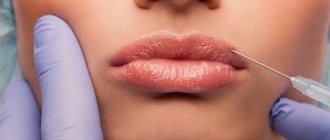Benefits of Hyaluronic Acid for Skin
Sodium hyaluronate is one of the most popular ingredients in cosmetics intended for skin care. The substance has an anti-aging effect. To see immediate results, you need to inject hyaluronic acid. The filler will attract and retain natural moisture, making the skin elastic and moisturized. Contour plastic surgery with hyaluronic acid is performed throughout the body. But the most popular treatment is the following areas of the face:
- nasolacrimal grooves;
- cheekbone;
- puppet lines;
- lips
Just one injection of hyaluronic acid can change the shape of the face, smooth out wrinkles and eliminate minor imperfections associated with insufficient hydration.
Hyaluronic acid is often suggested as an alternative to Botox. Unlike botulinum toxin, hyaluronate is naturally present in the body. Botox provokes paralysis of wrinkles, as a result of which facial expressions change and a mask effect is created. If you don’t like the result, you will have to wait quite a long time until the product is removed on its own. The main advantage of procedures using drugs based on hyaluronic acid: reversibility. The injected filler can be easily dissolved with hyaluronidase. To avoid complications, it is best to entrust the cosmetic procedure to a doctor.
But not only injections have a positive effect. High-quality cosmetics with hyaluronic acid can also smooth out wrinkles, slow down aging and thoroughly moisturize the skin. Creams and serums containing collagen and elastin are especially good. Regular use of such cosmetics will eliminate skin tightness, improve elasticity and even reduce scars and post-acne.
Benefits and harms
Proper use of the additive in cosmetic gels and creams helps to prolong the youth of the skin and its beauty. You can use it after 20 years, but there is no particular point in it. Even the best remedies in this case are addictive.
The benefits of the drug lie in the following aspects:
- Creates an invisible protective film on the surface of the skin that prevents the influence of destructive external factors.
- Retains water molecules, thereby smoothing out fine wrinkles.
- Relieves dryness, eliminates itching and roughness. Makes the skin soft, smooth and silky.
- Gives skin radiance.
- Promotes accelerated healing of wounds, scratches, cracks, calluses. Also helps in the fight against acne, pimples and blackheads.
Even knowing which acid is best suited for a particular case and purpose, one must not forget that hyaluronic acid has its side effects. The harm of a substance is manifested in the following aspects:
- Allergic reactions, including urticaria and anaphylactic shock.
- Quincke's edema.
- Redness of the skin.
- Get used to it with regular use.
The benefits of hyaluronic acid for joints
Hyaluronate injections are given not only to the face, but also to the joint area. The substance may be useful for people who suffer from osteoarthritis. The disease develops as a result of natural wear and tear of cartilage (the spongy material that protects joints). In the early stages, ultraphonophoresis and gel with hyaluronic acid may be prescribed. If physiotherapeutic procedures do not have the expected effect, the doctor will prescribe injection therapy. Even the first injection of hyaluronic acid into the knee can relieve pain. However, the full prescribed course of therapy must be completed to ensure long-term results. For mild or moderate osteoarthritis, the effect of injections will last from 6 months to a year. Then the injection of hyaluronic acid will have to be repeated.
It is necessary to understand that medications based on hyaluronic acid are not included in the official protocols for the treatment of joint diseases. Medicines containing hyaluronic acid are certified and tested. However, the results of official studies do not prove a direct relationship between the use of hyaluronic acid and joint restoration. Most often, doctors prescribe injections to patients who suffer from severe joint pain, but for certain reasons cannot take painkillers orally.
In any case, hyaluronic acid administered intra-articularly cannot restore cartilage. The polysaccharide is a substitute for synoval fluid, provides additional lubrication of the joints, but does not eliminate the need for surgery in the long term.
How are hyaluronic acid injections given into joints?
You should not sign up for the procedure on your own, without a referral from your attending physician. Although hyaluronic acid is safe for the body, it is better not to experiment with injections. For example, if the patient is already undergoing corticosteroid therapy, then it is necessary to wait at least two weeks before administering hyaluronic acid.
The duration of the course, the interval between injections and the drug are selected by the doctor. In the early stages of the disease, and also if there is no severe pain, one injection of hyaluronic acid is sufficient. But in most cases you will have to take a course of 3-5 injections with an interval of 7-10 days.
The injection itself should be done by an experienced doctor. Hyaluronic acid is not dangerous for the body, but if the drug does not get into the interarticular space, there will be no positive effect (unless the skin around the knee is nourished and smoothed out). Sometimes the procedure is performed under ultrasound guidance.
No special preparation is required on the part of the patient. First, the doctor will clean and degrease the puncture area. If the knee is swollen from excess synovial fluid, drainage may be performed first. For patients sensitive to pain, local anesthesia is offered before hyaluronic acid is administered. The procedure for administering the drug itself will not take even a minute.
From what age is it used?
It is not advisable to use hyaluron injections at a young age, since it is already synthesized by the body in sufficient quantities. It makes sense to replenish it locally only when absolutely necessary.
Up to 30-40 years of age, it is optimal to use external cosmetics with hyaluronate for preventive purposes. At the same time, you need to remember about protection from UV radiation, the balance of water in the body and the absence of bad habits.
At 40-50, cosmetologists include periodic injections of the substance, subject to the availability of home care with hyaluron.
For people over 50 years of age, injections with this polysaccharide are indicated to replenish it. At the same time, cosmetics with hyaluronate are not the main therapeutic agent, but an auxiliary one, aimed at consolidating the result and maintaining it.
Recovery after manipulation
The patient can return home immediately after being injected with hyaluronic acid. But in order to maximize the effect of the procedure, it is recommended to reduce physical activity at least in the first few days after leaving the clinic. Otherwise, there is a risk that the injected hyaluronic acid will not be absorbed as needed.
There are practically no side effects, provided there is no individual intolerance. Preparations containing hyaluronic acid are usually safe and well absorbed. Short-term side effects are usually related to the piercing itself. Patients complain of slight pain at the injection site and a slight accumulation of joint fluid.
Hyaluronic acid can be called a universal substance. Preparations containing polysaccharides are used for both beauty and health.
How does it affect the skin?
The main property of hyaluronate is water binding. Its molecules attract and hold water molecules. Thanks to water retention in the skin, it becomes smooth, elastic and healthy. Hyaluronic acid takes part in the transport of oxygen, lymphocytes and other blood cells to damaged areas, areas of irritation and inflammation. It is thanks to this that, with a sufficient level of the substance, healing occurs faster. Also, upon admission, it accelerates the process of synthesis of hyaluron itself, influencing fibroblast receptors and stimulating them to produce their own hyaluron.
Principles for choosing a product
Various pharmaceutical brands develop and produce a significant number of drugs with hyaluron in tablet form. It is impossible to say which company is better in this case. The choice depends on the availability of additives in products from different manufacturers: some will suit some, and others – others. Moreover, supplements should not cause side effects, in particular allergies. The tablets help in the fight against small wrinkles and in the recovery process after certain cosmetic procedures.
It is also important to understand that a dietary supplement is not a drug, so it is not subject to careful long-term monitoring. This means that you need to buy products from trusted companies with a good reputation - this is a guarantee of higher quality.
Hyaluron-binding proteins
In addition to molecular weight, the manifestation of the immunotropic effects of HA is influenced by the level of expression of HA receptors (hyaluronan-binding proteins) on the membranes of various immunocompetent cells, fibroblasts, keratinocytes, and endothelial cells.
Most of the HA exists in the intercellular matrix in free soluble form. Another part of HA is covalently bound to various proteins [48]. Hyaluronan-binding proteins, or hyaladherins, can be divided into several types:
- Proteins that bind HA to other extracellular matrix molecules, such as aggrecan and versican. By binding to them, HA forms the structure of different types of connective tissue.
- Proteins that act as cellular GC receptors, such as CD44, RHAMM, TNFIP6, SHAP, LYVE-1 and others.
Thus, the manifestation of the immunotropic effects of HA depends not only on its molecular weight, but also on the level of expression of hyaluronan-binding proteins and the function of immunocompetent cells. Taking into account the important role of hyaluronan-binding proteins in the manifestation of the unique immunological properties of HA, it is possible to develop a new strategy for immunomodulation and immunocorrection of chronic dermatoses, prevention and treatment of photo- and chronoaging of the skin, which will be based on the use of HA preparations of various molecular weights and combination preparations based on it.
Contraindications
- oncology (consultation with an oncologist is required);
- endocrine disorders (consultation with an endocrinologist is needed);
- diabetes;
- pregnancy, breastfeeding;
- bleeding disorders;
- taking blood thinning medications;
- exacerbation of chronic diseases;
- increased body temperature;
- herpes;
- cold;
- mental disorders;
- violation of the integrity of the skin;
- skin diseases;
- vascular pathologies;
- heart diseases.
How does the procedure work?
- Consultation. It eliminates contraindications to the procedure and determines the drug that will be used. Typically, facial correction requires two syringes of filler.
- Skin cleansing. The doctor or nurse removes makeup and impurities from the surface of the skin.
- Application of anesthesia. Some fillers contain lidocaine, but many patients require anesthetic cream to be applied before filler injections.
- Administration of the drug. Hyaluronic filler is usually injected into the tissue using a cannula, a flexible needle with a rounded tip. This contributes to minimal tissue trauma and faster healing. By distributing the filler under the skin, the doctor will create harmonious, symmetrical, youthful proportions that will noticeably refresh your appearance. At the same time, we always preserve the individual characteristics of the patient’s appearance, without altering it, but only improving what is given by nature.
- Repeated antiseptic treatment of the skin. The doctor then applies a skin soothing agent.
- Receiving recommendations from a cosmetologist.




